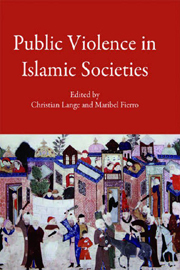 Public Violence in Islamic Societies
Public Violence in Islamic Societies Book contents
- Frontmatter
- Contents
- List of abbreviations
- Acknowledgements
- Introduction: Spatial, ritual and representational aspects of public violence in Islamic societies (7th–19th centuries ce)
- PART I Public violence and the construction of the public sphere
- 1 The case of Jacd b. Dirham and the punishment of ‘heretics’ in the early caliphate
- 2 Qāḍīs and the political use of the maẓālim jurisdiction under the cAbbāsids
- 3 From revolutionary violence to state violence: the Fāṭimids (297–567/909–1171)
- 4 Actions speak louder than words: reactions to lampoons and abusive poetry in medieval Arabic society
- PART II Ritual dimensions of violence
- PART III Representations of public violence
- Index
2 - Qāḍīs and the political use of the maẓālim jurisdiction under the cAbbāsids
from PART I - Public violence and the construction of the public sphere
Published online by Cambridge University Press: 12 September 2012
- Frontmatter
- Contents
- List of abbreviations
- Acknowledgements
- Introduction: Spatial, ritual and representational aspects of public violence in Islamic societies (7th–19th centuries ce)
- PART I Public violence and the construction of the public sphere
- 1 The case of Jacd b. Dirham and the punishment of ‘heretics’ in the early caliphate
- 2 Qāḍīs and the political use of the maẓālim jurisdiction under the cAbbāsids
- 3 From revolutionary violence to state violence: the Fāṭimids (297–567/909–1171)
- 4 Actions speak louder than words: reactions to lampoons and abusive poetry in medieval Arabic society
- PART II Ritual dimensions of violence
- PART III Representations of public violence
- Index
Summary
The role of the maẓālim jurisdiction is generally regarded as threefold by present-day historians. As ordinary courts – all grievances could in theory be brought to the caliph – the maẓālim symbolized the discretionary authority vested in the ruler who could, at any time, exercise a power that he would ordinarily delegate to other judges. Moreover, the maẓālim offered the possibility to claim damages for unjust acts committed by public servants, public officials or high-ranking dignitaries against whom the qāḍīs would find it difficult to take punitive actions. Finally, the maẓālim emerged as a possible recourse against the judgment of qāḍīs, and as such, functioned as a court of appeal. Although the institution goes back to the beginning of the cAbbāsid era, it was only systematically theorized in the 5th/11th century, in the works of al-Māwardī and Ibn al-Farrā, which makes it difficult to determine exactly when this type of justice was practiced in the early centuries of Islam. While the maẓālim are often referred to as independent institutions, the texts are not always explicit: in the opinion of L. Massignon and E. Tyan, al-Ḥallāj was one of its most famous victims, although no text clearly says that his judges held a maẓālim court. Indeed the maẓālim were not recognizable only by their name or by the judges sitting in the courts; they were mainly identified by their procedures: free from the limits of ordinary jurisdictions, judges could take a case without prior accusation.
- Type
- Chapter
- Information
- Public Violence in Islamic SocietiesPower, Discipline, and the Construction of the Public Sphere, 7th-19th Centuries CE, pp. 42 - 66Publisher: Edinburgh University PressPrint publication year: 2009


